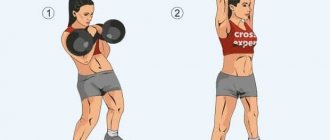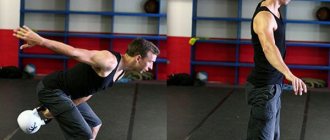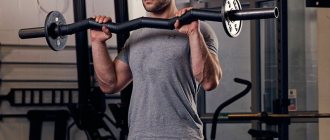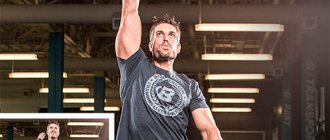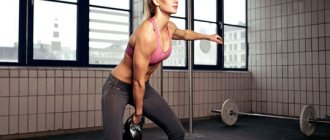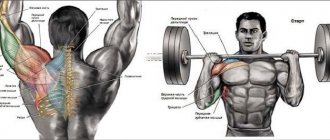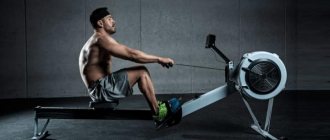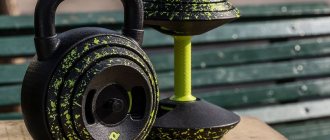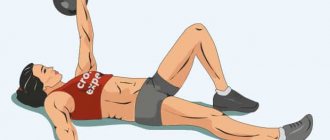| Emblem of the Kettlebell Lifting Federation |
| Weight-lifting |
|
| Theory |
|
| Inventory |
|
| Training |
|
| Competitive exercises |
|
| Preparatory exercises |
|
| Nutrition and recovery |
|
Rules for performing the exercise
Each exercise with weights is technically more difficult, so it is imperative to stretch your hands and shoulders well before starting the exercise so as not to injure your joints.
- Before starting the exercise, the kettlebell stands in front of you, feet shoulder-width apart. Take the weight in your hand.
- Swing the weight between your legs and throw it over your shoulder. The elbow of the working hand is pressed to the body. The torso is tilted back slightly to compensate for the weight of the kettlebell.
- Next, perform a squat so that, sharply extending your legs, you tear the weight upward.
- Next, return the kettlebell to your shoulder (springing your legs)
- Lower the weight down towards your groin area.
This is called a long cycle: first the weight is thrown to the shoulder, then the push, then returned to the shoulder and lowered down. Repeat the long cycle the required number of times with one hand, then with the other.
When working for time (usually 1 to 5 minutes), change hands every 5 to 10 repetitions. Find your optimal number of continuous repetitions with one arm. This could be, for example, 6, 7 or 9 repetitions.
Note: The long cycle jerk can be performed with two kettlebells at the same time. You can see the detailed technique for performing the exercise in the following video.
The video says that one of the key points of the exercise is holding the weights on the chest. A good place to start is to develop this skill. Hold two weights on your shoulders statically, maintaining correct technique. The elbows rest against the body, the shoulders are relaxed, the back is tilted back. The hand and forearm form a straight line. When swinging the weights, the body leans forward, the back is straight. Then the weight begins to move down and forward, moving the body back. We place our elbows point-blank. Next comes the kettlebell push. We push the projectile out with our feet, performing a squat. The arms are straightened vertically upward.
The video also explains the variations of this exercise: releasing weights on the shoulders through a support, releasing weights from the top position (a more complicated version, suitable for stronger shoulders), releasing plus a power lift. Choose the most convenient option for yourself.
Snatch in women
| VK (kg) | MSMK 24kg | MS 24kg | KMS 24kg | 1 view 16kg | 2 views 16kg | 3 views 16kg | 1 youth 16kg | 2 youth 16kg | 3 youth 16kg |
| 48 | — | — | — | 80 | 60 | 45 | 43 | 33 | 23 |
| 53 | — | — | — | 90 | 70 | 50 | 45 | 35 | 25 |
| 58 | — | — | — | 100 | 80 | 60 | 55 | 45 | 35 |
| 63 | 159 | 126 | 73 | 110 | 90 | 70 | 65 | 55 | 45 |
| 63+ | 181 | 146 | 86 | 125 | 100 | 85 | 75 | 65 | 55 |
Conditions for scoring from the judge and scoring lifts in the classic clean and jerk
The classic clean and jerk is performed with two kettlebells. 10 minutes of time are allotted for the exercise. After taking the weights from the platform, the athlete can no longer put them on the floor. After the weightlifter has placed the weights on the platform, the judge finishes the count. After pushing the weights from the chest in the upper position, the legs and arms must be straightened, there must be visible fixation, the head must look straight - after this the judge counts. When the weights are placed on the chest, it is forbidden to tear your arms away from the body; it is also forbidden to place the weights on your shoulders. If the weights fall from the chest, then the “stop” command comes from the judge.
You can read about the kettlebell push technique in the article on our website - Kettlebell push from the chest - the correct technique.
Conditions for counting lifts in the snatch exercise
The snatch exercise is performed with one kettlebell. Mandatory straightening of the legs and arms in the upper position and a visible stop (fixation). After this, the judge counts. The exercise also takes 10 minutes. Only 1 hand interception is allowed, and the athlete himself decides which hand to start with. It is prohibited to place the weight on the floor and throw the weight onto your chest or shoulder. If the weight touches the floor, then the command “stop” comes from the judge, not counting the striking. It is forbidden to raise your free hand above the level of your head and touch the body with your free hand and in any way help the movement of the weight. A detailed kettlebell snatch technique can be found at the link in the article - kettlebell snatch technique.
Conditions for scoring from the judge and scoring lifts in the long cycle clean and jerk
The long cycle push is also performed with two kettlebells. 10 minutes of time are allotted for the exercise. After taking the weights from the platform, the athlete can no longer put them on the floor. After the weightlifter has placed the weights on the platform, the judge finishes the count. One lift is a cast followed by a push (counts as 1 point). After pushing the weights from the chest in the upper position, the legs and arms must be straightened, there must be a visible fixation - after this the judge counts. When the weights are placed on the chest, it is forbidden to tear your arms away from the body; it is also forbidden to place the weights on your shoulders. After dropping the weights from above, a subsequent throwing of the weights onto the chest occurs, while it is forbidden to stop the weights at the bottom and touch the weights on the platform. If the weight touches the platform, then the “stop” command comes from the judge (if there is just a chirp, then the “stop” command will not follow).
Kettlebell weight
Competitions in Russia are held with weights weighing 16, 24 and 32 kg. For men, weights weighing 16 kg for youth categories, weights for adults weighing 24 kg, and weights for CMS and above - 32 kg. For girls, adult categories are performed with weights weighing 16 kg, and KMS and higher with weights weighing 24 kg.
Description of the exercise
The long cycle push of a kettlebell is basic in kettlebell lifting and is one of the most difficult, since it consists of several exercises: lifting a kettlebell to the chest with a swing, pushing a kettlebell with one hand. The exercise is considered more popular among men, but is also suitable for women. In competition, the long cycle clean and jerk is performed by both sexes.
This exercise consists of two independent exercises:
| Raising weights to the chest with a swing | Kettlebell push with one hand |
| A basic exercise in kettlebell lifting, which is aimed at developing the muscles of the shoulder trunk, and also serves as a lead-in exercise to the one-handed kettlebell push, the two-handed kettlebell push, and the full cycle kettlebell push. The exercise involves swinging a weight between your legs and lifting it onto your chest. | A basic competitive exercise in kettlebell lifting, which is aimed at developing endurance and working out the entire shoulder girdle. The one-arm kettlebell push is a more complex exercise and consists of pushing the weight vertically upward; during the push, the legs are squatted, thereby taking the load onto themselves. |
Training program
The following complex is suitable for athletes with some experience in kettlebell lifting who want to increase their results in the jerk of two kettlebells. It is also great for preparing for competitions.
For successful training, it is advisable to have the following set of weights: 16, 20, 22, 24, 26, 28 kg. As a last resort, you can use dumbbells.
6 week program:
| Week 1 | |
| Workout 1 | |
| 24 kg | 2 minutes |
| 20 kg | 3 min |
| 16 kg | 4 min |
| Workout 2 | |
| 24 kg | 3 min |
| 20 kg | 4 min |
| 16 kg | 5 minutes |
| Workout 3 | |
| 24 kg | 4 min |
| 16 kg | 6 min |
| Week 2 | |
| Workout 1 | |
| 24 kg | 2.5 min |
| 20 kg | 3.5 min |
| 16 kg | 4.5 min |
| Workout 2 | |
| 24 kg | 3.5 min |
| 20 kg | 4.5 min |
| 16 kg | 5.5 min |
| Workout 3 | |
| 16 kg | 8 min (walking) |
| Week 3 | |
| Workout 1 | |
| 26 kg | 2 minutes |
| 24 kg | 3 min |
| 20 kg | 4 min |
| Workout 2 | |
| 26 kg | 3 min |
| 24 kg | 4 min |
| 20 kg | 5 minutes |
| Workout 3 | |
| 26 kg | 4 min |
| 20 kg | 6 min |
| Week 4 | |
| Workout 1 | |
| 26 kg | 2.5 min |
| 24 kg | 3.5 min |
| 20 kg | 4.5 min |
| Workout 2 | |
| 26 kg | 3.5 min |
| 24 kg | 4.5 min |
| 20 kg | 5.5 min |
| Workout 3 | |
| 20 kg | 8 min (walking) |
| Week 5 | |
| Workout 1 | |
| 28 kg | 2 minutes |
| 26 kg | 3 min |
| 24 kg | 4 min |
| Workout 2 | |
| 28 kg | 3 min |
| 26 kg | 4 min |
| 24 kg | 5 minutes |
| Workout 3 | |
| 28 kg | 4 min |
| 24 kg | 6 min |
| Week 6 | |
| Workout 1 | |
| 28 kg | 2.5 min |
| 26 kg | 3.5 min |
| 24 kg | 4.5 min |
| Workout 2 | |
| 28 kg | 3.5 min |
| 26 kg | 4.5 min |
| 24 kg | 5.5 min |
| Workout 3 | |
| 24 kg | 8 min (walking) |
You can also download this program from this link.
An important point is the pace of the kettlebell push. If you want to achieve a result of 24 per 100 times, then 16 kg - 14-16 times/minute, 20 kg - 12-14 r/m, 24 kg - 10-12 r/m, 26 kg - 8-10 r/m , 28 kg - 6-8 r/m.
You can watch the technique of proper breathing in the following video:
Recipes for healthy eating
Beef meatballs in tomato sauce
- 9.9 g Protein
- 10.1 g Fat
- 25.9 g Carbohydrates
- 209.8 kcal
30-40 min.
- #second course
- #milk
- #carrot
- #dinner
- #breadcrumbs
- #parsley
- #vegetable oil
- #onion
- #spices
- #meatballs
- #tomato sauce
- #dinner
- #ground meat
- #garlic
Other recipes
Muscles involved in the exercise
Let's look at what muscles work when performing a long cycle push of a kettlebell. During the kettlebell push, a large number of different muscle groups work, the main load falls on the deltoid muscles and leg muscles. The triceps, biceps, forearm, quadriceps, gluteal muscles, trapezius muscles, upper back, and core muscles (lumbar muscles and abs) play a supporting role.
Some muscles work more, some less, which, in particular, depends on the technique of performing the push, but, nevertheless, the push allows you to work almost the entire body. It is especially important to practice coordination of movements, their synchronization and sequence, so as not to get confused and not cause injury to yourself.
Rank standards and records
The long cycle kettlebell jerk is a challenging competitive exercise. Below are the category standards for men and women, as well as Russian records among men with a 32 kg kettlebell.
TABLE OF DIFFERENT STANDARDS FOR MEN:
DC push (number of weight lifts in 10 minutes)
| Weight category (kilogram) | MSMK kettlebell 32kg | MS kettlebell 32kg | KMS kettlebell 32kg | I weight 24kg | II kettlebell 24kg | III kettlebell 24kg | I(u) kettlebell 16kg | II(u) kettlebell 16kg | III(u) kettlebell 16kg |
| 48 | — | — | — | — | — | — | 40 | 35 | 30 |
| 53 | — | — | — | — | — | — | 48 | 42 | 36 |
| 58 | — | — | — | 55 | 45 | 35 | 55 | 48 | 40 |
| 63 | 59 | 44 | 35 | 60 | 49 | 39 | 61 | 51 | 42 |
| 68 | 72 | 56 | 45 | 65 | 54 | 43 | 66 | 56 | 46 |
| 73 | 76 | 62 | 48 | 70 | 58 | 46 | 71 | 61 | 51 |
| 73+ | — | — | — | — | — | — | 74 | 64 | 54 |
| 78 | — | — | — | 74 | 62 | 50 | — | — | — |
| 85 | 82 | 69 | 55 | 79 | 66 | 54 | — | — | — |
| 85+ | 88 | 75 | 58 | 90 | 75 | 60 | — | — | — |
TABLE OF DIFFERENT STANDARDS FOR WOMEN:
DC push (number of weight lifts in 10 minutes)
| Weight category (kilogram) | MSMK kettlebell 24kg | MS kettlebell 24kg | KMS kettlebell 24kg | I weight 16kg | II kettlebell 16kg | III kettlebell 16kg |
| 63 | 59 | 44 | 35 | 60 | 49 | 39 |
| 63+ | 72 | 56 | 45 | 65 | 54 | 43 |
Records of Russia. Men (long cycle) - kettlebell 32 kg.
| Weight category | Last name, first name | Region | Result | Year of establishment |
| 63 | Ryabkov Alexey | Tyumen region | 74 | 2015 KR |
| 68 | Usoltsev Alexander | Tyumen region | 80 | 2015 CR |
| 73 | Belyaev Ivan | Belgorod region | 87 | 2014 World Cup |
| 78 | Chuev Pavel | Belgorod region | 84 | 2017 CR |
| 85 | Vasiliev Denis | Saint Petersburg | 91 | 2014 World Cup |
| 95 | Balabanov Sergey | Rostov region | 93 | 2017 KR |
| St. 95 | Denisov Ivan | Chelyabinsk region | 110 | 2014 World Cup |
Classic biathlon for men
| VK (kg) | MSMK 32kg | MS 32kg | KMS 32kg | 1 view 24kg | 2 views 24kg | 3 views 24kg | 1 youth 16kg | 2 youth 16kg | 3 youth 16kg |
| 48 | — | — | — | — | — | — | 110 | 75 | 50 |
| 53 | — | — | — | — | — | — | 120 | 85 | 55 |
| 58 | — | — | — | 90 | 70 | 50 | 130 | 95 | 60 |
| 63 | 192 | 126 | 75 | 100 | 80 | 60 | 140 | 105 | 65 |
| 68 | 210 | 146 | 83 | 110 | 90 | 65 | 150 | 110 | 70 |
| 73 | 222 | 162 | 95 | 120 | 95 | 70 | 160 | 120 | 75 |
| 73+ | — | — | — | — | — | — | 170 | 125 | 80 |
| 78 | — | — | — | 130 | 105 | 80 | — | — | — |
| 85 | 234 | 178 | 117 | 140 | 110 | 85 | — | — | — |
| 85+ | 246 | 190 | 126 | 160 | 130 | 100 | — | — | — |
Alternative Exercises
The push press is one of the most popular CrossFit strength exercises. It is one of the basic weightlifting exercises that works large muscle groups and also develops coordination and flexibility.
Press press
Military kettlebell press with two hands. The military press is one of the best exercises for the entire shoulder core, and the kettlebell, as an unusual apparatus, helps develop coordination of movements.
Military two-hand kettlebell press
Clean and push. To perform this exercise you will need a barbell. The exercise is complex and quite difficult. Lift the barbell off the floor through a squat. When the bar reaches your knees, quickly lift the barbell toward your chest. The bar rests on the front of the shoulders. Straighten up completely and, as you exhale, press the barbell overhead.
Clean and jerk
Auxiliary exercises
Lifting the weights onto the chest with a swing. The exercise is a component of the long cycle push of the kettlebell, and also serves as a leading exercise to the exercise in question. It is aimed at developing the muscles of the shoulder body.
Raising weights to the chest with a swing
The one-arm kettlebell snatch is also an auxiliary exercise for TDC. Volumetrically works the rectus dorsi muscles for casting; the hand is most intensively loaded for the same. Something like “aerobic exercise” during the development of general endurance for a long cycle push.
One-arm kettlebell snatch
Weight-lifting
Kettlebell lifting is a cyclic sport, which is based on lifting weights as many times as possible in a given period of time in a standing position. In order for an athlete to achieve high results, systematic training is necessary, aimed primarily at increasing strength and endurance.
History of kettlebell lifting
The kettlebell is one of the oldest sports equipment for weight training in strength training, analogues of which were used thousands of years ago. The first weight dates back to ancient Greece, when special products of a similar shape were carved from stone for the training of the first Olympians. Later, such weights, very similar to modern ones, were used in the training of Slavic and Turkic peoples.
Much later, metal weights appeared, which began to be cast with a strictly defined weight. This made it possible to use them for accurate weighing of goods, medicines, spices, precious metals and stones. Even later, weights weighing from hundreds of grams to several pounds appeared, ensuring the movement of clock mechanisms. The next stage in the evolution of kettlebell lifting is very closely related to the development of trade and the appearance of metal weights. At the beginning of the 17th century, an interpretation of the term “weight” appeared in Russian dictionaries, which originated from the Persian language (geran, geranium - weight, difficult).
The appearance of metal sports weights in Russia occurred in the 18th century, and it is not for nothing that their shape resembles a cannonball with a handle. According to historians, it was the gunners who created such a sports equipment for training the speed of loading guns. The convenient shape and weight of one, one and a half and two pounds allowed the weights to quickly spread throughout all segments of the population. Kettlebells began to be widely used by strongmen in circus arenas, fairs and holidays.
Exercises with weights became most widespread in the European part of pre-revolutionary Russia. For centuries, they were part of the program of national holidays and became an integral part of the culture of the peoples who lived here.
An invaluable contribution to the development of domestic athletics was made by the doctor Vladislav Frantsevich Kraevsky, who lived in St. Petersburg at the end of the 19th century. After graduating from the medical faculties of Warsaw and Berlin universities, in 1885, on August 10, he founded the first circle of athletic enthusiasts in Russia. The founding date of this circle is rightfully considered the birthday of Russian weightlifting and kettlebell lifting, and Kraevsky himself is considered the father of Russian athletics. Traveling through Austria-Hungary, Germany, Italy, Spain, in each of these European countries he became acquainted with the features of sports and physical education. Returning to Russia, Kraevsky began giving lectures on these topics and organizing demonstration performances by foreign athletes. In his own home, he opened an athletic gym where anyone could train.
Until now, the heroes of Russia demonstrated their strength only at fairs, holidays, in the circus, in the army, in the navy, but after August 10, 1885, there was a tendency to hold various official competitions to identify the strongest people, organized precisely as purely sports competitions. Weightlifting immediately took center stage (until the mid-20th century), which is explained by its popularity throughout the world, as well as its inclusion in the program of the Olympic Games. Kettlebell lifting in this period can only be considered as fun for rural youth and as an integral part of the power stunts of circus performers.
In 1897, the St. Petersburg Athletic Society was opened, which sought to adopt the traditions of the Kraevsky Circle. Count Ribopierre was elected chairman of the society. He continued the work of his predecessor Kraevsky, the “father of Russian athletics,” under whose leadership a whole galaxy of brilliant wrestlers and strongmen were brought up.
In pre-revolutionary Russia, such outstanding athletes as Ivan Poddubny, Ivan Zaikin, Georg Gakkenschmidt, Nikandr Vakhturov, Vladimir Krylov and many others were fond of exercises with kettlebells.
Ivan Poddubny is a famous strongman who amazed the whole world with his abilities; his performances attracted sold-out crowds in Russia, France, Italy, Germany and America. Ivan Poddubny performed in the circus until he was 70 years old, and this was the artist’s personal record.
Peter Krylov. A circus performer, a wrestler who demonstrated the best skills in working with weights.
Petr Krylov squeezed 134 kilograms in the “wrestling bridge” position. I squeezed 114.6 kilograms with one left hand. In addition, with his arms spread out to the sides, he held a weight weighing 41 kilograms in each of them.
Ivan Zaikin demonstrated his phenomenal strength in the circus arenas. During his performance, ten people carried a sea anchor weighing 25 pounds into the circus arena, then the athlete Ivan Zaikin came out, easily threw the anchor onto his shoulders and walked with it around the circle of the arena. Another power exercise, more complex and heavy: the assistants laid a rail or I-beam on Ivan’s shoulders like a rocker. Then 10-15 people hung on each end of the rail. Soon a large deflection appeared on the rail. In one of the museums in Paris, Ivan Zaikin’s “gift” is still kept - a rail he bent into a ring.
Nikandr Vakhturov is a great Russian wrestler, winner of many honorary prizes, winner of prestigious international competitions, world champion. For his incredible strength, Nikandr Vakhturov was called “The Bear from Nizhny Novgorod.” Already at the age of 18, he demonstrated a trick that no one can repeat today - he threw a two-pound weight over a railway carriage.
The next important milestone in the development of kettlebell lifting was the first All-Union Strongman Competition, which was held in Moscow in the summer of 1948. The winners of republican competitions took part in it. The competitions were held in 4 weight categories: up to 60 kg, up to 70 kg, up to 80 kg and over 80 kg. The competition participants performed a 32 kg kettlebell snatch with one hand and a two-32 kg kettlebell clean and jerk. It was allowed to do push-ups and push-ups of weights. The time for performing the exercises was not limited.
The most important stage in the history of kettlebell lifting was the approval by the Union of Sports Societies and Organizations of the RSFSR in 1962 of the rules for competitions in classical triathlon. Eventing included: 1) kettlebell press with the left hand and the right;
2) push of two weights from the chest; one-handed kettlebell snatch.
Participants were divided into 4 weight categories: 60, 70, 80 and over 80 kg. A sports classification was developed, which was part of the All-Russian classification of national sports.
In 1969, triathlons were introduced: the press with one arm, the snatch with the other arm, and the two-arm kettlebell jerk. In addition, all those involved in special kettlebell sections were trained not only in lifting a kettlebell, but also in the ability to juggle it. Unified competition rules and the All-Union classification have been developed. Modern competition rules provide for the performance of two exercises - a push of two weights with two hands and a jerk first with one, and then, without lowering it to the platform, with the other hand. The inclusion of kettlebell lifting in the Unified All-Union Sports Classification and the holding of national championships played a positive role in its development, however, improving the growth of technical results required improving the forms of organizing competitions, making additions and changes to the rules. For this purpose, in 1989, a 10-minute time limit was established when performing classical exercises. Competitions began to be more spectacular and emotional.
Since the 70s, meetings between USSR athletes have been held on an ongoing basis, and sport has also been cultivated in the Armed Forces. For a long time, competitions in kettlebell lifting exercises were held according to different rules; in order to popularize them among all segments of the population, the rules were changed towards simplification.
If bodybuilding in the USSR was not encouraged due to the fact that it took resources away from weightlifting, then kettlebell lifting was strongly approved. The only obstacle to the official recognition of this sport as an independent one was the lack of constant rules; even during one season, competitions could be held according to different rules.
In 1985, kettlebell lifting received official recognition, and in 1987, the All-Union Kettlebell Lifting Federation of the USSR was created. In 1992, the European Kettlebell Lifting Union was created and, after it, the International Kettlebell Lifting Federation. Kettlebells received official entry into the international arena. The first European Championship was held in 1992, and in 1993 the first World Championship. Since then, international competitions at various levels have been held regularly. Currently, more than 20 countries are actively participating in the international kettlebell movement. National federations have been created in Greece, Latvia, Lithuania, Estonia, Russia, Ukraine, Belarus, Kazakhstan, and the USA. Representatives from Great Britain, Germany, Hungary, Poland, Finland, Norway, Moldova, Australia, and Canada take part in the competitions and in the work of official structures. In European countries, kettlebells have become more widespread in the field of fitness and as an aid to developing physical qualities in strength sports.
Since the beginning of the 90s, they began to hold international competitions both among adults and among youth and juniors. As a rule, athletes from Russia, the Baltic states and the former Soviet republics participate in these competitions, but athletes from far abroad (Greece, USA, Canada, Italy, Hungary, Germany, etc.) are increasingly coming.
The governing body in Russia is the All-Russian Kettlebell Sport Federation (VFGS).
The governing international body is the International Kettlebell Lifting Union, which unites 56 national federations.
The pages of weightlifting achievements recorded many names of athletes who made a great contribution to the development of kettlebell lifting.
Valentin Dikul. Being paralyzed, he managed to achieve fame as a weightlifter. Performances involving tossing balls weighing 45 kg, lifting barbells, people and cars were watched by millions of people around the world. His ability to throw a weight with one hand was included in the Guinness Book of Records, but Dikul’s invented weight of 80 kg is still considered unique. Since then, many powerlifting competitions have included lifting and benching such an unusual weight in their program. It is considered aerobatics to do snatches with a golden weight. Lifting it is included in the traditional disciplines of extreme power.
Sergey Rachinsky is a Russian kettlebell lifter, Honored Master of Sports of Russia in kettlebell lifting, Honored Trainer of Russia in kettlebell lifting, 12-time champion of Russia and nine-time World champion in kettlebell lifting, seven-time record holder of the Guinness Book of Records. He entered the Guinness Book of Records thanks to his unique abilities - he snatched a kettlebell weighing 16 kilograms more than one and a half thousand times per hour.
Evgeny Lopatin is an Honored Master of Sports, five-time World Champion, nine-time Russian Champion. He was the first in history to push 2 weights weighing 32 kilograms more than 100 times in 10 minutes.
Sergey Mishin - Soviet and Russian athlete, the first Honored Master of Sports in kettlebell lifting in the USSR, Honored Master of Sports of Russia (ZMS), 21-time champion of Russia (biathlon), 7-time champion of the USSR (biathlon), winner of the 10th USSR Spartakiad in 1991 (biathlon), winner of the Commonwealth of Independent States Championship in 1992 (biathlon), 11-time World Champion (biathlon), 11-time European Champion (biathlon), 6-time winner of the Russian Cup and World Cup (long push cycle). Awarded the Order of Merit for the Fatherland, II degree.
Ivan Denisov is an Honored Master of Sports of Russia, 9-time world champion, 17-time Russian champion, 4-time European champion in kettlebell lifting. Absolute Russian and world record holder in all kettlebell lifting exercises.
Modern kettlebell lifting
It is difficult to compare kettlebell lifting with any other sport - in powerlifting the main indicator is strength, in weightlifting - speed and strength. The main quality that kettlebells develop is strength endurance. At the same time, the athlete must have the qualities of a weightlifter and a track and field athlete. A kettlebell sports master can easily show good results in middle and long distance running, and, at the same time, demonstrate remarkable strength when performing classic powerlifting exercises. It is worth noting that in kettlebell lifting there are the most “long-livers” due to the low level of injury. With the correct and dosed approach to exercise, you can lift weights until a very old age without any risk to health.
Today, Russian kettlebell lifting is on the rise again. Our athletes traditionally take prizes at international competitions. In addition to sports disciplines (snatch, clean and jerk, long cycle push), weightlifters devote time to power juggling, the entertainment of which motivates new people to come to the sport. Exercises with weights are used by shock athletes and wrestlers. Exercises with weights help develop strength endurance, coordination, and strengthen ligaments. Unlike weightlifting, kettlebell lifting is not dangerous; both women and children successfully practice it.
Competitions are held with weights weighing 32 kg, 24 kg and 16 kg, which have standard dimensions: height 280 mm, body diameter 210 mm, handle diameter 35 mm, handle length 115 mm.
Competitive kettlebell lifting has two main disciplines: classical biathlon and long cycle kettlebell jerk (LC) for men and kettlebell snatch for women. The long cycle kettlebell push (LC) is a movement consisting of throwing weights from a hanging position to the chest, performing a push and then lowering them to a hanging position. Classic biathlon consists of a classic (short) push of weights and a jerk of the weights alternately with each hand. In order to plan your result, the athlete must develop a certain pace for performing the exercise and, if possible, stick to it for all 10 minutes or speed up in the last 2-3 minutes. As we see, the athlete performs work that is cyclical in nature.
The kettlebell jerk is a competitive kettlebell lifting movement consisting of a series of intermediate movements. It is considered one of the heaviest in kettlebell lifting, both in terms of the physical and functional capabilities of the athlete. The push does not need to be worked either comprehensively or in phases, since the technical master is decisive factor in competitions.
The push itself in kettlebell lifting is presented in two versions: the classic, or so-called short push, and the long cycle push.
The classic clean and jerk, like the kettlebell snatch, is part of the kettlebell double event. The exercise is performed as follows: after the “Start” command, the athlete throws the weights onto his chest and begins to lift them up. The competition goal is to complete the most lifts within 10 minutes.
It is recommended for exercisers and power lifters to include a push in the training program when working out the functions natural qualities, which allows you to develop fine motor skills, coordination and postural muscle layers.
The long cycle is the most difficult exercise both from the point of view of execution technique and from the point of view of the athlete’s physical expenditure. This is due to the work that the athlete performs. When performing the exercise, almost all major muscle groups are involved: muscles of the back, legs, arms, shoulder girdle. Thus, the result directly depends on the technical preparedness of the athlete and his physical and functional capabilities.
The technique of performing the exercise is similar to the technique of performing the classic push. However, there are also distinctive features, which consist mainly in the dumping and throwing of weights.
So, the starting position when performing a push in a long cycle, in contrast to the classic push, is the weights hanging below. From this position, the athlete performs a throw to the chest, followed by pushing out and lowering to the starting position - this is one cycle or one lift.
The kettlebell snatch is a classic kettlebell exercise that uses the muscles of the entire body.
The snatch can be included in the classical combined event program along with the clean and jerk for men, or it can be represented as a separate competitive exercise for women.
The snatch, unlike the clean and jerk, is performed with one kettlebell for 10 minutes with each hand alternately. When performing a snatch, only one change of hands is allowed.
When performing a snatch, the athlete begins the movement from the initial “kettlebell down” position. In the trajectory of movement of the weight in a snatch, we can conditionally distinguish 4 points: the point of swing, the point of detonation of the weight, the point of inserting the hand into the arch of the weight, and the end point - the point of fixation of the hand with the weight.
- Table of rank standards for men:
1. Double event (the number of points scored in 10 minutes in each exercise) * points are awarded: for 1 kettlebell push - 1 point, for 1 kettlebell jerk - 0.5 points
| Weight category (kilogram) | MSMK kettlebell 32kg | MS kettlebell 32kg | KMS kettlebell 32kg | I weight 24kg | II kettlebell 24kg | III kettlebell 24kg | I(u) kettlebell 16kg | II(u) kettlebell 16kg | III(u) kettlebell 16kg |
| 48 | — | — | — | — | — | — | 110 | 75 | 50 |
| 53 | — | — | — | — | — | — | 120 | 85 | 55 |
| 58 | — | — | — | 90 | 70 | 50 | 130 | 95 | 60 |
| 63 | 192 | 126 | 75 | 100 | 80 | 60 | 140 | 105 | 65 |
| 68 | 210 | 146 | 83 | 110 | 90 | 65 | 150 | 110 | 70 |
| 73 | 222 | 162 | 95 | 120 | 95 | 70 | 160 | 120 | 75 |
| 73+ | — | — | — | — | — | — | 170 | 125 | 80 |
| 78 | — | — | — | 130 | 105 | 80 | — | — | — |
| 85 | 234 | 178 | 117 | 140 | 110 | 85 | — | — | — |
| 85+ | 246 | 190 | 126 | 160 | 130 | 100 | — | — | — |
2. DC push (number of weight lifts in 10 minutes)
| Weight category (kilogram) | MSMK kettlebell 32kg | MS kettlebell 32kg | KMS kettlebell 32kg | I weight 24kg | II kettlebell 24kg | III kettlebell 24kg | I(u) kettlebell 16kg | II(u) kettlebell 16kg | III(u) kettlebell 16kg |
| 48 | — | — | — | — | — | — | 40 | 35 | 30 |
| 53 | — | — | — | — | — | — | 48 | 42 | 36 |
| 58 | — | — | — | 55 | 45 | 35 | 55 | 48 | 40 |
| 63 | 59 | 44 | 35 | 60 | 49 | 39 | 61 | 51 | 42 |
| 68 | 72 | 56 | 45 | 65 | 54 | 43 | 66 | 56 | 46 |
| 73 | 76 | 62 | 48 | 70 | 58 | 46 | 71 | 61 | 51 |
| 73+ | — | — | — | — | — | — | 74 | 64 | 54 |
| 78 | — | — | — | 74 | 62 | 50 | — | — | — |
| 85 | 82 | 69 | 55 | 79 | 66 | 54 | — | — | — |
| 85+ | 88 | 75 | 58 | 90 | 75 | 60 | — | — | — |
- Table of rank standards for women:
1. DC push (number of weight lifts in 10 minutes)
| Weight category (kilogram) | MSMK kettlebell 24kg | MS kettlebell 24kg | KMS kettlebell 24kg | I weight 16kg | II kettlebell 16kg | III kettlebell 16kg |
| 63 | 59 | 44 | 35 | 60 | 49 | 39 |
| 63+ | 72 | 56 | 45 | 65 | 54 | 43 |
2. Snatch (number of weight lifts in 10 minutes)
| Weight category (kilogram) | MSMK kettlebell 24kg | MS kettlebell 24kg | KMS kettlebell 24kg | I weight 16kg | II kettlebell 16kg | III kettlebell 16kg | I(u) kettlebell 16kg | II(u) kettlebell 16kg | III(u) kettlebell 16kg |
| 48 | — | — | — | 80 | 60 | 45 | 43 | 33 | 23 |
| 53 | — | — | — | 90 | 70 | 50 | 45 | 35 | 25 |
| 58 | — | — | — | 100 | 80 | 60 | 55 | 45 | 35 |
| 63 | 159 | 126 | 73 | 110 | 90 | 70 | 65 | 55 | 45 |
| 63+ | 181 | 146 | 86 | 125 | 100 | 85 | 75 | 65 | 55 |
- Conditions for compliance with standards:
| 1. | The tables show the number of lifts in 10 minutes, for sports disciplines the names of which contain the word “biathlon” - the number of points scored in 10 minutes in each exercise. |
| 2. | Sports disciplines whose names contain the word “biathlon” consist of a “jerk” exercise and a “snatch” exercise. |
| 3. | Points in sports disciplines whose names contain the word “both-event” are awarded: 1 clean and jerk - 1 point, 1 snatch - 0.5 points. |
| 4. | The sports title of master of sports of international class (MSMK) is awarded for fulfilling the norm when taking 1-2 places at the World Championships, 1 place at the European Championships, 1 place at the World Cup, 1 place at the European Cup, 1 place at the World Championships among juniors and junior women (19-22 years old), 1st place at the European Championship among juniors, juniors (19-22 years old), 1st place at other international sports competitions included in the EKP, held according to the World Cup regulations. |
| 5. | To be awarded the MSMC, it is necessary to carry out doping control at the specified sporting competitions. |
| 6. | The sports title of master of sports (MS) is awarded for fulfilling a standard at sports competitions not lower than the status of other all-Russian sports competitions included in the EKP. |
| 7. | The sports title of Candidate Master of Sports (CMS), I sports category is awarded for fulfilling standards at sports competitions not lower than the status of other official sports competitions of a constituent entity of the Russian Federation. |
| 8. | II-III sports categories are assigned for fulfilling standards at sports competitions not lower than the status of other official sports competitions of the municipality. |
| 9. | I-III youth sports categories are assigned for fulfilling standards at other official sports competitions of any status. |
| 10. | Russian championships, all-Russian sports competitions included in the EKP, among persons with an upper age limit, championships of a federal district, two or more federal districts, championships of a constituent entity of the Russian Federation, other official sports competitions of a constituent entity of the Russian Federation among persons with an upper age limit, championships municipal formation, other official sports competitions of the municipal formation among persons with an upper age limit are held in age groups: juniors, juniors (19-22 years), boys, girls (17-18 years), boys, girls (14-16 years) . |
Benefits of kettlebell lifting
Kettlebell training is incredibly effective. They are in many ways more useful than training using dumbbells and exercise machines in gyms and health centers. This multifunctional equipment can successfully replace almost any sports equipment. The dynamic nature of kettlebell training guarantees a full-fledged workout that combines strength and cardio exercises.
The unique shape of the kettlebell (a handle and a dense ball in which most of the weight is concentrated) is fundamentally different from the type of dumbbell. It allows the body to perform a variety of ballistic and strength exercises based on natural, fluid movements. Although most kettlebell exercises can be done with dumbbells, performing snatches or swings with dumbbells is not very convenient. A dumbbell, unlike a kettlebell, will not become an extension of your arm, since it does not have a handle. The handle of the weight allows you to comfortably hold it in your hand so that the projectile can freely swing to the side due to a push from the hip, which gives the impulse that initiates the swing. Swinging dumbbells is more problematic: you have to load your arms beyond necessity, since the weight is distributed to the sides and not concentrated in the ball. In addition to providing a secure grip, the kettlebell's handle also allows you to switch between your right and left hands, extending your workout time while providing an intense cardio workout. The weight of the kettlebell forces more muscles to work and allows you to perform exercises that provide a wider range of motion. Increased range of motion improves body flexibility and strengthens deep stabilizing muscles.
Exercises with a kettlebell help increase the athlete's strength. Strength endurance training is a great way to stay fit and lose weight.
Kettlebell exercises teach the athlete how to deal with an ever-changing center of gravity.
Kettlebell exercises train forearm muscles and grip strength. Training the forearm muscles and grip strength occurs because the handle of the kettlebell is thicker than that of a barbell or dumbbell. As society moves further away from manual labor, our grip weakens. Kettlebell training will help change this trend. The unique shape of the kettlebell brings one unique component to grip training. It is a combination of dynamic and statistical muscle contractions. This muscle contraction occurs during an attempt to control the change in the movement of the center of gravity of the projectile.
Exercises with weights improve the functioning of the body's cardiovascular and respiratory systems. Many kettlebell exercises have an element in which the athlete holds the apparatus above his head. In this position, the muscles involved in the respiratory process begin to work, without allowing the work of other muscles to interfere with this process. This muscle work activates the most important respiratory muscles, which play an important role in the functioning of the cardiovascular and respiratory systems of the body.
Performing exercises with kettlebells does not require specially equipped rooms. Kettlebell exercises require very little usable space. Kettlebells do not require expensive equipment and can be stored under other equipment.
Kettlebell exercises combine strength training and cardiovascular training; there is no difference between playing sports and real life.
Benefits of kettlebell training: - Increased endurance; — Fast fat burning; — Increasing muscle strength without increasing additional volume; — Strengthening the body; — Full body workout; — Pumping the back muscles; — Strengthening the shoulder girdle; — Increased body flexibility; — Psychological stability; — Reduction of musculoskeletal pain.
Kettlebell fitness is a direction that can be formulated as a set of exercises performed cyclically, mainly in an aerobic-anaerobic mode, aimed at working out the main muscle groups of the body.
The kettlebell, like no other sports equipment, can simultaneously cover almost all human muscle groups, providing trainees with good results in losing excess weight, as well as in bringing the body into a fit, athletic state. In addition, with a certain focus of training, the kettlebell easily helps to significantly improve the functional condition of the trainee. That is why such a currently popular sport as CrossFit constantly uses kettlebells as an integral part of training complexes.
Kettlebell fitness takes its origins from kettlebell lifting. That is why among the exercises with kettlebells, a fairly large place is occupied by exercises that are in one way or another related to the exercises of competitive kettlebell lifting: the clean and jerk, the snatch, the long cycle jerk. The basis for successful exercises with kettlebells is the correct selection of the necessary exercises and the choice of the desired intensity of the exercises. Lifting a kettlebell for 10 minutes requires burning 200 calories, which is the highest energy expenditure compared to even running, which is considered the main fat burner.
As in any other fitness area, exercises with kettlebells should be systematized and planned depending on the desired result. It is no secret that a training program is built depending on the desired result.
Training with a kettlebell refers to cyclic training, since in order to achieve a greater effect, training should be built on the principle of performing certain work in a certain period of time.
It is this approach that will allow you to effectively burn subcutaneous fat, increase the functionality of the body and, as a result, tone the muscular system.
Based on the cyclic component of kettlebell training, the effectiveness of the work performed can be associated with the heart rate while performing the work. It's no secret that in order for the body to use fat reserves as an energy source, the trainee must work for, say, 20 minutes with a heart rate of 120 beats per minute. And to increase functionality, you need to work at a pulse of 140-170 beats per minute. Accordingly, to effectively burn subcutaneous fat, the training load must be selected in such a way that the work is carried out at the required heart rate.
Basic exercises in kettlebell fitness include the same movements that are basic in kettlebell lifting. These are the snatch, swing, clean and jerk and squats. Performing only basic movements can already load all muscle groups well. Also in kettlebell fitness, other movements are used, for example, lunges, throwing an apparatus onto the chest, bending over with an apparatus, sumo squats, etc. Combinations of all these movements will also bring good results. So in kettlebell fitness, a thruster is used (squatting and pushing the projectile up), a lunge with twisting of the body, and so on.
Types of weights:
Champion
Designed to organize training for professional kettlebell lifters and prepare for international and world kettlebell lifting competitions. A wide range of weights allows you to build an ideal training process and intelligently program your workouts to achieve the best results. The entire line of championship weights is represented by kettlebells weighing from 6 to 40 kg in increments of 2 kg. Each weight has its own color.
Competitive
Competition kettlebells are sports kettlebells adopted as a competition standard by the All-Russian Kettlebell Sports Federation. Russian championships, championships and other kettlebell lifting competitions are held on such kettlebells. World kettlebell lifting championships are held on competitive kettlebells under the Ural Kettlebell brand and the latest world records have been set. Kettlebell lifting champions from around the world recognize these kettlebells as the best in the world.
Ural
Ural kettlebells are sports weights designed for training at home and in gyms. The shape of the “body” of the kettlebell and the shape of the handle are as close as possible to competitive kettlebells. More stringent requirements are applied to the accuracy of the weight of Ural weights compared to amateur weights. Ural kettlebells are semi-professional training kettlebells, used in preparation for kettlebell lifting competitions, used in kettlebell fitness, crossfit and juggling with kettlebells.
Amateur
sports weights designed for home exercises. An ideal option for those starting their journey in kettlebell lifting or those interested in kettlebell fitness, CrossFit and other types of functional training using kettlebells. They are distinguished by their low price and less stringent requirements for weight accuracy.
Plastic
Plastic weights are sports weights intended for training at home and in training rooms. They have a number of advantages over cast iron weights: precise weight, low price, no need to equip a safety surface on the floor. Plastic kettlebells are widely used in kettlebell fitness, are used in kettlebell training and are perfect for training at home.
Collapsible
Collapsible weights are unique weights in design, representing three weights in one - 16, 24 and 32 kg.
Equipment for kettlebell lifting
In kettlebell lifting, as in other sports, special equipment is used to obtain greater effect from training and protect against injury.
Equipment for kettlebell lifting includes the correct shoes, clothing, safety belt, wristbands and knee wraps.
Shoes are one of the most important elements of equipment, as incorrect shoes can interfere with the correct execution of exercises and cause injuries.
Shoes are hard leather shoes that are tightly laced along their entire length. In addition, there is a hard sole and a small hard heel.
Weightlifting shoes are ideal shoes for competitive kettlebell lifting exercises; the foot in such shoes is rigidly fixed and does not tilt to the side, and the heel allows you to maintain balance. That is, stability increases and the possibility of injury to the ankle joint decreases.
Athletic belt
In kettlebell lifting, a belt that is wide at the back and narrow at the front is used. Weightlifters rest their elbows on their stomachs - for them, narrowing the belt in front is simply necessary. The rules of kettlebell lifting have a limit on the width of the back of the belt and is 12 centimeters. The main task of the belt is to insure your back and prevent it from bending.
Knee bandages allow you to protect the athlete’s joints, ligaments and tendons from various injuries and evenly distribute the load on them.
Wristbands are used to avoid pain and injury in the wrists. The width allowed by the rules is up to 10 centimeters.
Clothes for weight lifters include cycling shorts (track shorts), weightlifting tights, a T-shirt or tank top. The uniform must not cover the participant's elbow and knee joints.
Bicycle shorts (tracks) - introduced by the rules since 2005 for the convenience of judges. When using bicycle shorts instead of regular shorts, the fixation in the knee joint is better visible. For athletes, bicycle shorts are very convenient when performing “snatch” and “long cycle push” exercises.
T-shirt (undershirt). According to the rules of kettlebell lifting competitions, athletes can use a T-shirt so that the lower part of the sleeve is 10 centimeters above the elbow. This was also done for the purpose of more convenient judging of fixations. For the “push” and “long cycle push” exercises, it is more convenient to use a T-shirt made of cotton material, since when the elbows rest on the stomach, such material does not stretch and does not slip, unlike synthetic ones.
The uniform can be of any color, plain or multi-colored; a distinctive sign, emblem, or federation (association) can be applied to the suit. The athlete's name can be printed on a suit or any other piece of personal equipment.
Bibliography
1. “Kettlebell lifting.” Gorbov A.M.
2. “Weightlifting and teaching methods.” Duganov Yu.V., Zaitsev V.B., Verkhoshansky Yu.V.
3. “Kettlebell lifting.” Solonevich I.L.
4. “Kettlebell biathlon.” Tretyakov I.I.
5. "Famous strongmen." Shaposhnikov Yu.
6. “The history of the entry of kettlebell lifting into the festive culture of the peoples of Russia.” Shikunov A.N.
7. “Weights. Sport of the strong and healthy.” Vorotyntsev A.I.
8. “Kettlebell lifting. Technique, teaching methods, training and planning." Romashin Yu.A.
9. “Kettlebell lifting: exercise technique.” V.F. Vasiliev
10. “Modern methods of training the muscles of the hands and forearms in kettlebell lifting.” Telesh V.E. Litvinovich S.M., Flerko A.N.
